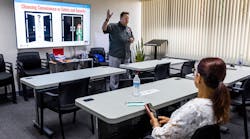In the U.S. there are more than 130,000 public and private schools serving more than 50 million students.
Recent acts of violence, especially active shootings in schools, have led school administrators and public officials to reevaluate their security protocols in schools and on campuses.
Unfortunately, school shootings continue to rise: there were 23 school shootings this past year. Nine students and four school employees were killed and 21 injured.
We’ve seen it before with tragic events that seared the names of campuses into our minds: Marjory Stonemen Douglas High School in Parkland, Fla. (14 students and three staff members killed), Robb Elementary School in Uvalde, Texas (19 students and two teachers killed and 17 others injured) and The Covenant School in Nashville, Tennessee (three students and three adults killed).
Revisit Priorities
Based on years of experience with school security and active shooter situations, I have come to the realization that these types of shootings will continue to happen until school administrators make security a top priority before and not when something happens.
This is not about politics, gun control or mental illness. While those are critical issues, administrators need to focus on physically securing their schools and their campuses so students and teachers can have a safe learning environment.
Before taking any action or spending money on security, one of the most important steps school board members and school administrators can take is to request a campus security review from a qualified school security expert who can help design a full security plan for securing the entire campus.
The comprehensive security review is designed to reduce incidents, pinpoint critical areas of vulnerability and identify strengths and weaknesses. It also helps schools review existing crisis response plans to address existing and new threats.
Environmental Factors
Ideally, the security review should cover the following three areas: the community, the exterior of the campus and inside the school.
The review will look at the community where the school is located and address local concerns that could impact the school such as sex offenders, gangs, weapons, drugs, and vacant or abandon buildings.
In addition, the review can help identify safe passages for children who walk to school and work with local businesses, banks, stores, and gas stations. Finally, the community review will identify nearby hazards, airports, trains, and potential natural disasters.
The review of the exterior of campus will focus on lighting, fencing, gates, signage, parking areas, exterior doors, and other buildings such as school trailers, and athletic fields.
What to Evaluate
The review of the inside of school will focus on interior doors, glass doors and windows (especially on the first floor where entry is accessible), classrooms, offices, cafeteria, gymnasiums, auditoriums, restrooms and hallways, utility, storage areas and others.
The results of these reviews serve as the initial phase to develop a course of action. The strategic plan created from the review will help reduce incidents and prevent potential liabilities.
In addition to the comprehensive security review, all school administrators should take immediate action to implement a closed-campus policy and review their emergency/crisis plans and lockdown procedures.
Schools need to hold appropriate and announced drills with emergency responders, and practice responses to different emergency situations, e.g., active shooter. Note: let parents and media know about the drills in advance.
Schools around the country are soft targets so we need to be creative and use the resources that are available today that would stop all weapons from coming onto their schools.
It is recommended that all schools have an assigned police officer often called a School Resource Officer (SRO). However, if unavailable, schools can consider hiring off duty police officers and or contract with security officers that are certified and trained.
Don’t Forget Tech
Any security plan will undoubtedly include security technology, but no single security technology can protect a K-12 campus; true protection comes from many layers of security. It is imperative to evaluate your communication/fire systems frequently: PA system, phones, radios, duress buttons, fire alarms, video surveillance and other devices.
Funding and grants for schools may be available from State or Federal Government agencies. As available, these funds can be used to upgrade existing systems or implement recent technologies.
In closing, school administrators should ensure they have a comprehensive safety and security plan in place. The plan should be a living document that is continually updated to meet the challenges of a particular school and campus.
Protecting students, staff and visitors to a school campus is a huge undertaking that requires planning, diligence, and ongoing attention. Let’s have a safe school year!






